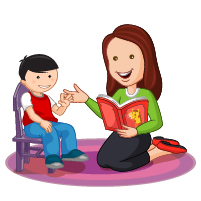|
Why is there a need to teach comprehension strategies? According to researchers, reading strategies should be taught, and are highly beneficial to all students. This would involve teaching comprehension strategies one at a time, allowing students to practice and apply the strategy, while teachers provide feedback, reviews and allow opportunities for independent practice.
Here are some key components to teaching reading comprehension strategies:
Making Connections: Readers make connections to other texts, themselves and the world as they read.

- Does the text remind you of something else you have read?
- Has something like this ever happened to you?
- Is this text similar to something happening in the world?
- How did your connections help you understand the text?
- How are you the same or different to the characters in the book?
- How does this text relate to your life?
- Is this text, the same or different from the types of text you like to read?
Predicting: Readers use written and visual clues from the text as well as their own personal experiences to make predictions about what might happen before, during and after the reading.
- What clues can you get from the visuals and graphics in this text?
- What might happen next? What clues help you to make this prediction?
- Has your prediction been confirmed? Do you need to modify your prediction?
- What information from your own life helped you make this prediction?
Summarising: Readers identify the main idea of the text and retell them, in order, in their own words.
- Can you retell the text in your own words?
- What are the most important events or ideas in this text?
- What order did the events happen in?
- If you were to write a review of this text, what would you say?
- What is the main point of this text?
- What key words would you write down to help you summarize this text?

Questioning: Readers ask and answer questions to clarify meaning and ensure they understand what they have read. They ask questions, before, during and after reading.
- What was the author’s intentions in writing this text?
- Can I relate to the character? How are they alike and different?
- Why did the author portray the character in that way?
- What questions did you have?
- What would you like to know more about?
- How did this text make you feel?
Monitoring: Readers stop to think when they have a range of strategies to regain understanding.
- What was the author’s intentions in writing this text?
- Can I relate to the character? How are they alike and different?
- Why did the author portray the character in that way?
- What questions did you have?
- What would you like to know more about?
- How did this text make you feel?
|



